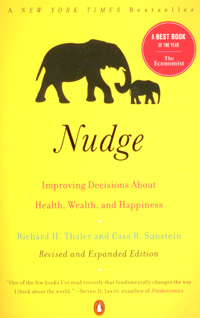
Nudge: Improving Decisions About Health, Wealth, and Happiness
by Richard H. Thaler and Cass R. Sunstein
Based on behavioral economics, Nudge is about “choice architecture.” Sometimes people don’t have enough information or expertise to make a good decision. Other times they may be too busy to think about it, so they rely on intuition or heuristics (rules of thumb and biases). Choice architects can improve decision making by nudging people in the right direction.
The authors use the term “libertarian paternalism.” The first part refers to freedom of choice—nudges are not mandates. The latter part is about influencing choices to make the choosers better off. In the context of 401K enrollment, the goal is to help participants make intelligent choices to maximize their retirement benefit. In the context of a school cafeteria, the goal could be to encourage healthier food choices.
Simplification can be a nudge. “One study finds that the more options in the [401K] plan, the lower the participation rates.” Disclosure can be a nudge; EPA mileage stickers on new cars help consumers make informed decisions. Default choices are another way to nudge, since many people go with whatever requires the least effort. Opt-in and Opt-out are also forms of choice architecture.
The authors discuss a number of public policy issues, such as Medicare plans, healthcare reform, school choice, marriage and civil unions, and organ donor programs. Some of their ideas are likely to be controversial, but I think that’s beside the point. The book about how behavioral economic principles can be applied to influence choices.
Thaler, Richard H., and Cass R. Sunstein. Nudge: Improving Decisions about Health, Wealth, and Happiness. Rev. and Expanded ed. New York: Penguin Books, 2009. Buy from Amazon.com
Disclosure: As an Amazon Associate I earn from qualifying purchases.
4 thoughts on “Nudge”
Comments are closed.